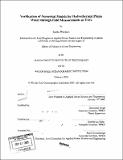| dc.contributor.advisor | Hanumant Singh. | en_US |
| dc.contributor.author | Wichers, Sacha | en_US |
| dc.contributor.other | Woods Hole Oceanographic Institution. | en_US |
| dc.date.accessioned | 2007-10-19T20:26:25Z | |
| dc.date.available | 2007-10-19T20:26:25Z | |
| dc.date.copyright | 2005 | en_US |
| dc.date.issued | 2005 | en_US |
| dc.identifier.uri | http://hdl.handle.net/1721.1/39173 | |
| dc.description | Thesis (S.M.)--Joint Program in Applied Ocean Science and Engineering (Massachusetts Institute of Technology, Dept. of Ocean Engineering; and the Woods Hole Oceanographic Institution), 2005. | en_US |
| dc.description | Includes bibliographical references (p. 63-65). | en_US |
| dc.description.abstract | Hydrothermal vents discharge superheated, mineral rich water into our oceans, thereby providing a habitat for exotic chemosynthetic biological communities. Hydrothermal fluids are convected upwards until they cool and reach density equilibrium, at which point they advect laterally with the current. The neutrally buoyant plume layer can have length scales on the order of several kilometers, and it therefore provides the best means to detect the presence of vent fields on the seafloor, which typically have length scales on the order of a few meters. This thesis uses field measurements of the velocity, temperature and particulate anomalies associated with the TAG hydrothermal plume to demonstrate that tidal currents exert a strong impact on the plume shape, and to provide new constraints on the thermal power of the TAG hydrothermal system. The results show that the power output of the TAG system is on the order of 6000 MW, which is up to two orders of magnitude greater than previous estimates, and that there is considerably more entrainment than had previously been assumed. | en_US |
| dc.description.statementofresponsibility | by Sacha Wichers. | en_US |
| dc.format.extent | 65 p. | en_US |
| dc.language.iso | eng | en_US |
| dc.publisher | Massachusetts Institute of Technology | en_US |
| dc.rights | M.I.T. theses are protected by copyright. They may be viewed from this source for any purpose, but reproduction or distribution in any format is prohibited without written permission. See provided URL for inquiries about permission. | en_US |
| dc.rights.uri | http://dspace.mit.edu/handle/1721.1/7582 | |
| dc.subject | /Woods Hole Oceanographic Institution. Joint Program in Applied Ocean Science and Engineering. | en_US |
| dc.subject | Ocean Engineering. | en_US |
| dc.subject | Woods Hole Oceanographic Institution. | en_US |
| dc.subject.lcsh | Hydrothermal vents | en_US |
| dc.subject.lcsh | Tidal currents | en_US |
| dc.subject.lcsh | Plumes (Fluid dynamics) | en_US |
| dc.title | Verification of numerical models for hydrothermal plume water through field measurements at TAG | en_US |
| dc.type | Thesis | en_US |
| dc.description.degree | S.M. | en_US |
| dc.contributor.department | Joint Program in Applied Ocean Physics and Engineering | en_US |
| dc.contributor.department | Woods Hole Oceanographic Institution | en_US |
| dc.contributor.department | Massachusetts Institute of Technology. Department of Ocean Engineering | |
| dc.identifier.oclc | 61253275 | en_US |

